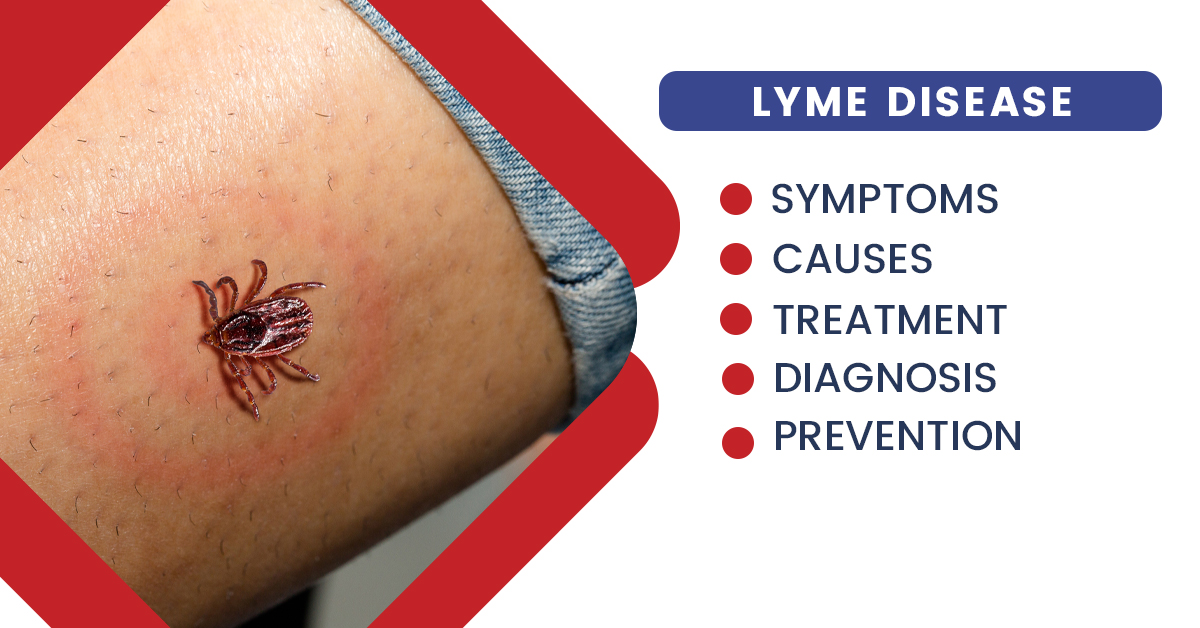What is Lyme Disease?
The bacteria that causes Lyme disease, Borrelia burgdorferi, is spread by the bite of an infected deer tick (also known as a black-legged tick). The disease is not carried by common “dog ticks” and “wood ticks.”
In Lyme, Connecticut, and two other communities, several children were diagnosed with juvenile rheumatoid arthritis in 1975, which led to the first identification of Lyme disease, also known as borreliosis. Researchers discovered that the spread of arthritis was brought on by deer tick bites.
Symptoms of Lyme Disease:
Some of the more typical early signs of Lyme disease include the following:
- a flat, circular rash anyplace on your body that resembles a red oval or bull’s-eye
- fatigue
- joint pain and swelling
- muscle aches
- headache
- fever
- swollen lymph nodes
- sleep disturbances
- difficulty concentrating
The symptoms of Lyme disease in children are typically the same as in adults.
They typically go through
- fatigue
- joint and muscle pain
- fever
- other flu-like symptoms
These symptoms could appear right after following the infection or months or even years later.
- neck stiffness and severe headaches.
- Other parts of the body have erythema migrans (EM) rashes as well.
- facial paralysis (loss of muscle tone or droop on one or both sides of the face).
- significant joint pain and swelling due to arthritis, especially in the knees and other major joints.
- Tendon, muscle, joint, and bone discomfort comes and goes.
- palpitations in the heart or an irregular heartbeat (Lyme carditis).
- episodes of breathlessness or dizziness
- inflammation of the spinal cord and brain.
- painful nerves
- Numbness, tingling, or shooting pains in the hands or feet.
Untreated late Lyme disease can develop up to a year after the first infection. Symptoms and signs include
- bouts of recurring joint swelling (arthritis). Usually, major joints like the knee are impacted by this.
- “Brain fog,” or difficulty focusing, is a type of brain injury or encephalopathy.
- Your entire body, including your muscles, organs, and skin, suffers from nerve damage (polyneuropathy).
What causes Lyme Disease?
Bacteria are the cause of Lyme disease. Typically, this is caused by the bacterium Borrelia burgdorferi. It is transmitted to people when an infected tick bites them. Ticks are responsible for transmitting it (also called deer ticks or black-legged ticks).
Any area of your body can become infected by these ticks. However, they are frequently discovered in concealed locations including your groin, armpits, and scalp. For the tick to transmit the bacterium to you, you often need to be attached to them for 36 to 48 hours or longer.
What Are the Stages of Lyme Infection?
There are three stages:
- Early localized Lyme. Fever, chills, headache, enlarged lymph nodes, sore throat, and a rash that resembles a bulls-eye or is circular, red, and at least 2 inches long are all flu-like symptoms.
- Early disseminated Lyme. A rash that may or may not be a bulls-eye rash, flu-like symptoms include pain, numbness, or weakness in your arms and legs, changes in your vision, heart palpitations, and Bell’s palsy, a form of facial paralysis
- Late disseminated Lyme. After the tick bite, this may occur weeks, months, or even years later. Arthritis, excruciating weariness, migraines, vertigo, insomnia, and confusion are possible symptoms.
10% of those who receive treatment for a Lyme infection never fully recover. Three main symptoms may develop later on: weariness, short-term memory loss, and joint or muscular pain. Post-treatment Lyme disease syndrome is the term used for this. Due to its similarity to other diseases’ symptoms, it might be challenging to diagnose. It cannot also be verified by a blood test.
Risk factors of Lyme Disease:
Your risks of contracting Lyme disease might be impacted by where you live or travel. Your line of work and your favorite outdoor pursuits are both examples. The following are the most typical risk factors for Lyme disease:
- spending time in a grassy or woodland region. Most of the Northeast and Midwest’s heavily forested areas are home to deer ticks. In these areas, children who spend a lot of time outside are particularly at risk. Adults who work outside are also more vulnerable.
- having skin exposed. Ticks can quickly cling to exposed skin. Wear long sleeves and long pants to protect yourself and your kids if you live in a tick-prone area. Keep your dogs out of the tall weeds and grasses.
- not swiftly and properly eliminating ticks. If a tick remains attached to your skin for 36 to 48 hours or more after biting you, bacteria from the bite may enter your bloodstream. If a tick is removed within two days,
Complications of Lyme Disease:
Untreated Lyme disease can cause:
- Lyme arthritis causes chronic joint inflammation, especially in the knee.
- neuropathies and facial palsy are examples of neurological symptoms.
- cognitive flaws, such as memory loss.
- abnormalities in the heart’s rhythm.
How can Lyme Disease be prevented?
Avoiding regions where deer ticks are common, particularly wooded, bushy areas with long grass, is the greatest approach to preventing Lyme disease. By taking a few straightforward steps, you can lower your risk of contracting Lyme disease:
- Clues: hide. Wear shoes, long pants tucked into your socks, a long-sleeved shirt, a hat, and gloves while in grassy or forested regions. Avoid strolling through low bushes and long grass and try to stay on pathways. Leash your dog at all times.
- Employ insect repellents. Apply DEET-containing insect repellent to your skin with a 20% concentration or higher. Children should be covered in repellent by their parents, keeping their hands, eyes, and mouths free.
Remember that chemical repellents can be hazardous, so pay close attention to the instructions. Buy pretreated garments or apply permethrin-containing goods on clothing. - Try to keep ticks out of your yard. Where ticks live, remove the bushes and leaves. Regularly cut your yard. To deter rodents that spread ticks, carefully stack wood in regions that are dry and sunny.
- Ticks should be checked on your children, pets, and clothing. After being in woodland or grassy regions, be extra cautious. Deer ticks are frequently barely larger than the head of a pin, so unless you look closely, you might not find them.
Showering as soon as you enter the house is beneficial. Ticks frequently stay attached to your skin for several hours. Unattached ticks might be removed by taking a shower and using a washcloth. - Do not presume that you are immune. There is a possibility of multiple Lyme disease cases.
- Use tweezers as soon as possible to remove a tick. Hold the tick firmly around its mouth or head. Instead of squeezing or crushing the tick, draw slowly and gradually. Once the entire tick has been removed, dispose of it by soaking it in alcohol or flushing it down the toilet. Next, clean the bite area with an antiseptic.
Lyme Disease Diagnosis:
A study of your medical history, which includes looking for tick bite reports or evidence of living in an endemic area, is the first step in the diagnosis of Lyme disease.
In order to check for the existence of a rash or other Lyme disease symptoms, a doctor or another healthcare provider will also do a physical examination. It is not advised to test for early localized infection.
Blood tests are most accurate when antibodies are detectable a few weeks after the first infection. A doctor may request any of the following tests:
- Antibodies against Borrelia burgdorferi are found using the ELISA method, or enzyme-linked immunosorbent assay.
- A positive ELISA test result is verified using a western blot. It looks for antibodies against particular Borrelia burgdorferi proteins.
- People with persistent Lyme arthritis or symptoms of the neurological system are evaluated using polymerase chain reaction (PCR). It is carried out on cerebrospinal fluid or joint fluid (CSF). Due to its low sensitivity, PCR testing on CSF is not typically advised for the diagnosis of Lyme disease. The diagnosis is not ruled out by a negative test result. In contrast, if examined before receiving antibiotic therapy, the majority of persons will have positive PCR results in joint fluid.
How is Lyme Disease treated?
The disease Lyme is treated with antibiotics. The sooner treatment begins, the quicker and more thorough the recovery will be.
Antibiotics:
- oral antibiotics- are the most recommended treatment for Lyme disease in its early stages. Adults, young children, pregnant or nursing women, and children older than eight typically receive amoxicillin or cefuroxime, while adults and children older than eight typically receive doxycycline.
Antibiotic regimens typically run for 14 to 21 days, but other research indicates that regimens lasting 10 to 14 days are equally effective. - antibacterial intravenous- Your doctor could advise intravenous antibiotic therapy for 14 to 28 days if the condition affects the central nervous system. Even though it could take some time for you to feel better from your symptoms, this is helpful in removing the infection.
A reduced white blood cell count, mild to severe diarrhea, colonization, or infection with other antibiotic-resistant organisms unrelated to Lyme are just a few of the side effects of intravenous antibiotics.


